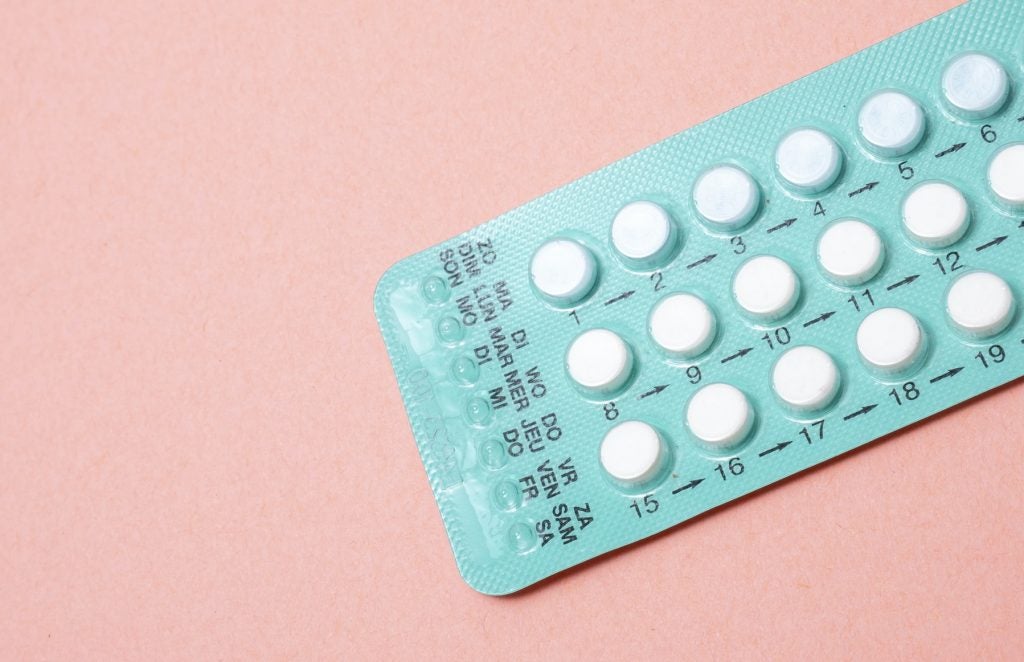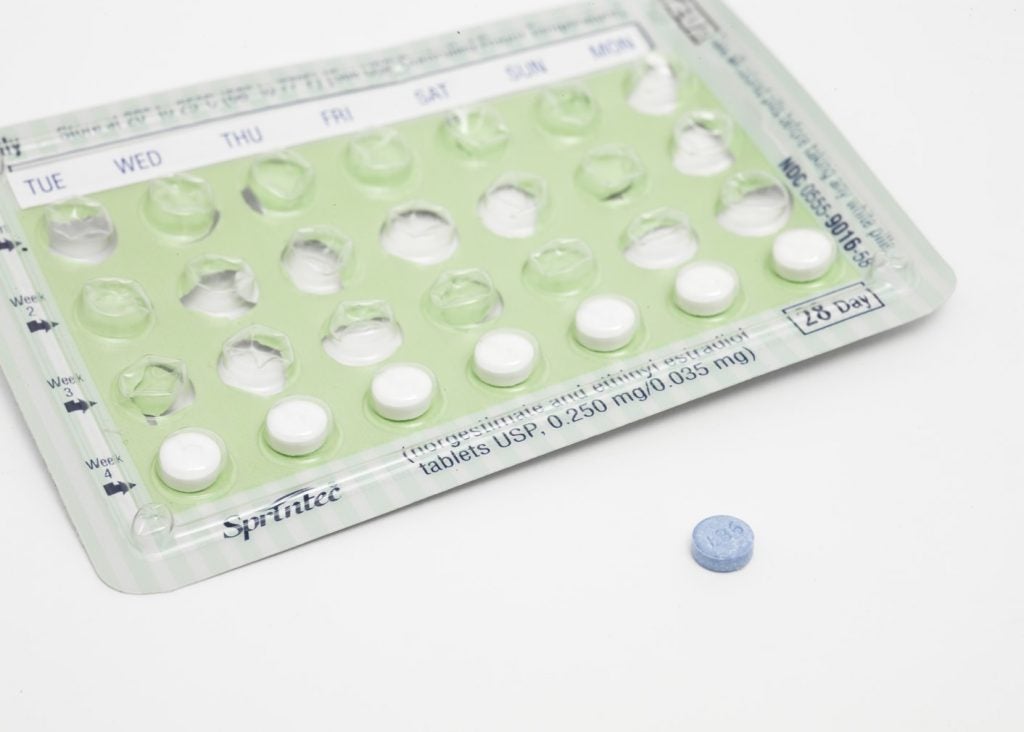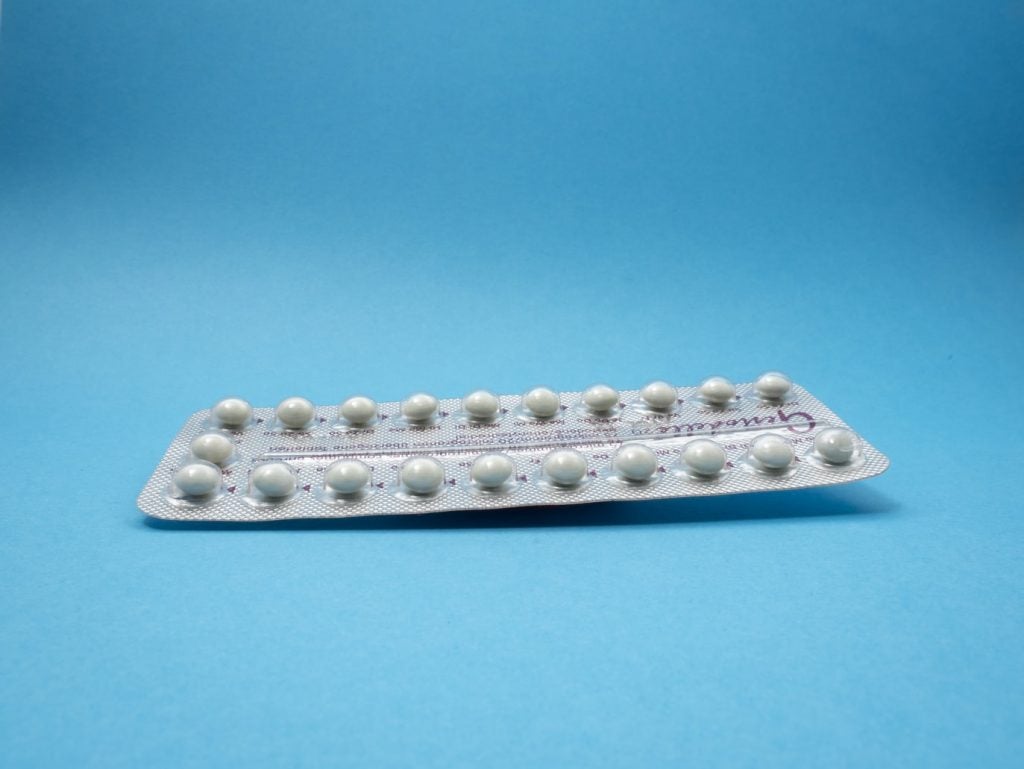
The progestin-only pill, also known as the “mini-pill,” is a type of oral contraceptive or oral birth control pill. The pill contains the hormone progestin and, unlike the combination pill, does not contain estrogen. Due to the lack of estrogen, many users report feeling fewer or no side effects compared to other oral contraceptives. One monthly pack of progestin-only pills contains 28 “active” pills, each with a small dose of progestin, unlike the combination pill, which includes a week of placebo or “inactive” pills. Because every pill is an active pill, users must take each pill at the same time daily.³ The progestin-only pill, if used correctly, is a highly effective way of preventing pregnancy, though it does not protect against any sexually transmitted infections. Out of all women using contraceptives, nearly 20 percent are on the progestin-only pill.
How They Work
The progestin-only pill prevents pregnancy by changing the physical and chemical environment of the female reproductive tract. In this new environment, it is more difficult for fertilization to occur as the progestin causes the cervical mucus to thicken.³ The thickening of the cervical mucus physically prevents sperm from entering the uterus and fallopian tubes to fertilize an egg. Additionally, the progestin thins the lining of the uterus, making it difficult for a fertilized egg to implant itself, which dramatically decreases the risk of pregnancy. It also suppresses ovulation (prevents the discharge of an egg from the ovaries into the fallopian tubes) as it makes the body “think” it is pregnant. If users take the pill at the same time daily and never miss a dose, it should be at optimal effectiveness and reduce the risk of pregnancy.

How They Should Be Taken
Progestin-only pills must be taken at the same time every day for optimal effectiveness. These pills are almost immediately reversible as it only takes about 24 hours for the small amount of ingested progestin to leave the body. If each pill is not taken at the same time every day, the cervical mucus will become thinner, and sperm will be able to pass through the cervix, reducing its effectiveness. If the user takes a pill more than three hours later than their usual time, a back-up birth control method (such as a condom) should be used for at least 48 hours. Users should not take breaks between pill packs as this can result in irregular bleeding and make the pill less effective.⁶ Some medications, including antibiotics, anti-HIV medication, and drugs that prevent seizures, will interfere with the mini pill. Make sure to use a backup method such as a condom while taking these medications. Users should also consult with a doctor about these medications and their potential side effects and interference with the minipill.
Users can begin taking the pill at any time unless they are pregnant or potentially pregnant. People who think they may be pregnant should not start taking the pill. If one begins a new pack on the first day of their menstrual period, the pill will start working within 48 hours, so it is best to use a backup method during those first two days. If the user begins taking the pill at any other time during their menstrual cycle, it is recommended that they abstain from sexual intercourse or use a backup contraceptive for the first seven days after starting the pill. If a user switches from the “combo pill” to the progestin-only pill, they should start taking the progestin-only pack on the day after they last took an active combination pill.³
Progestin-only Pill vs. Combination pill
The progestin-only pill may not work for everyone because it must be taken at the same time every day or within three hours of the set time. People who have taken the combination pill and experienced estrogen-related side effects such as decreased libido, breast tenderness, migraines, or gastrointestinal distress may benefit from switching to progestin-only pills because it has far fewer side effects.³ The minipill is often advised for people with vulvas who are smokers, have high blood pressure, heart disease, blood clotting issues, endometriosis,¹ and are past the age of 35. Before starting an oral contraceptive, be sure to get tested for any potential blood clotting health conditions such as Factor V Leiden.
Breast-feeders may also be good candidates for the minipill because only trace amounts of hormones enter the breast milk, and it does not affect breast milk supply. This may be preferable to the combination pill because evidence demonstrates that the estrogen in it interferes with milk production. People who are unable to take the pill at the same time daily may not be a good candidate for the Progestin-only pill. Another pill may be more beneficial for those who do not want irregular bleeding or spotting or who have experienced oral contraceptive failure before.⁶
What to do if You Miss a Pill:
If a user misses a pill, they should take it as soon as possible and continue taking the remaining pills at the usual time. A pill is considered a missed pill if it is taken three hours after the standard time. It is best to abstain from sex after missing a pill or use a backup birth control method for the next 2-7 days. If one engages in unprotected sex after missing any number of pills, they might consider using emergency contraception. After missing the pill and being sexually active, if one’s period does not arrive within 4-6 weeks, they should take a pregnancy test.⁵ Vaginal bleeding or spotting after missing pills is common, but users should not stop taking the pill if they experience this.⁶ It is best to consult a medical professional if the vaginal bleeding remains for a prolonged period of time or is recurring.⁶
Effectiveness of Progestin-only Pills:
When Progestin-only pills are used exactly as directed, also known as “perfect use,” less than 1 in 100 people will become pregnant in the first year of use. With the rate of imperfect use, which is called “typical use,” the progestin-only pill is 91% effective, meaning that 9 out of 100 people will become pregnant in the first year of use.⁵ These pills are typically less effective than the combination pill. Because most people are “typical users,” it is recommended to combine oral contraceptives with the male or female condom to best ensure the prevention of pregnancy as well as sexually transmitted diseases.⁵ The minipill does not in any way protect against any form of sexually transmitted disease or infection.⁵
Progestin Only Pills and Endometriosis

Endometriosis is a disorder where tissues similar to the tissue lining the inside of the uterus, called the endometrium, grow outside of the uterus.¹Endometriosis is extremely common in people with vulvas. Still, many people are unaware they have this disorder because there are few endometriosis specialists in the world, and it is not yet well known to most people. Endometriosis can cause severe pain, especially during menstrual cycles. This is a primary symptom of the disorder.⁴ While menstrual cramps are common, people with endometriosis experience far more painful cramps than most people.¹ Progestins can help treat endometriosis because when they are taken long-term, they thin the uterine lining, stopping regular periods. Progestins also reduce the chances of developing endometriosis lesions and cysts.²
Advantages of the Progestin-only Pill
In addition to avoiding the potential side effects of estrogen in combination birth control pills, there are also other advantages of the progestin-only pill. These advantages include decreased risk of uterine and ovarian cancer. Those on the pill may also experience lighter bleeding during menstrual cycles, less cramping, and reduced PMS symptoms. If users do get pregnant while taking the pill, the fetus will not be harmed by the small amount of progestin in it. The minipill is immediately reversible if the user wants to get pregnant. The progestin-only pill has many advantages that make it a viable and attractive birth control option for many people with vulvas.

Disadvantages and Risks
As with most birth control methods, the progestin-only pill also has potential side effects and drawbacks.
- Users must remember to take the pill every day at the same time
- It may be less effective than the combination pill
- If a user becomes pregnant, it can be challenging to recognize the symptoms, and there is a higher chance of ectopic pregnancy
- About one-half of people taking the progestin-only pill experience irregular menstrual bleeding and spotting between periods, especially after a missed pill
- Other side effects include acne, breast tenderness, decreased libido, mood changes, depression, headaches, nausea, ovarian cysts, and weight gain. Consult a doctor if side effects are concerning
- The pill does NOT protect against sexually transmitted infections. Condoms should be used to reduce the risk of spreading or contracting STIs
When choosing a form of birth control, people should consider the potential advantages and disadvantages of each method.
Abnormal Symptoms

If users experience severe stomach or abdominal pain, chest pain, shortness of breath, coughing up blood, persistent headaches, vision changes, loss of sensation in any body part, and severe calf or thigh pain while taking the minipill, they should report these symptoms to a doctor immediately. These are all abnormal and potentially dangerous symptoms. If a user’s period is more than 45 days late, they should consult a doctor.⁵
Concluding Remarks
The progestin-only birth control pill, when used correctly, offers people with vulvas a reliable way to prevent pregnancy. It also allows users to avoid the potential side effects of estrogen, a hormone found in the combination pill. The progestin-only pill must be taken consistently at the same time every day for maximized effectiveness. The progestin-only pill can be extremely beneficial to reduce the risk of pregnancy and minimize menstrual cycle side effects. There is no contraceptive method that is perfect for everyone, but with such a wide variety of choices available, users can be sure to find one that works best for them. Consult a doctor to discuss the best birth control options, as there are many different options to choose from.
References
- Casper, R. F. (2017, February 2). Progestin-only pills may be a better first-line treatment for endometriosis than combined estrogen-progestin contraceptive pills. Fertility and Sterility.
- Mayo Foundation for Medical Education and Research. (2018, July 24). Endometriosis. Mayo Clinic.
- Mayo Foundation for Medical Education and Research. (2020, December 29). Minipill (progestin-only birth control pill).
- Medical treatments for endometriosis. Endometriosis Medical Treatment – Brigham and Women’s Hospital. (n.d.).
- Parenthood, P. (n.d.). Are birth control pills effective?: Do birth control pills work? Planned Parenthood.
- Zigler, R. E., & McNicholas, C. (2016, December 14). Unscheduled vaginal bleeding with progestin-only contraceptive use. American Journal of Obstetrics and Gynecology.
Last Updated: 0 November 2021.
